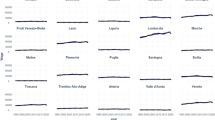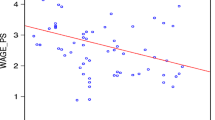Summary
Starting from traditional neo-classical results, a theory is developed in which, in addition to prices, labour productivity and unemployment, the degree of unionization, the profit rate and the shifting-on of direct taxes and social security contributions influence nominal contract wages. A separate theoretical framework is constructed for wage drift.
It is furthermore shown how the wage theory presented is related to Friedman-Phelps specifications. After a discussion of wage policy and its potential influence on wages, wage equations are estimated for the key bargaining sector as well as for wage followers. After their characteristics have been dealt with, as well as the effects of wage policy and the role of wage drift, the relationship between key bargaining, inflation and employment is analysed, showing that the model presented is able to explain stagflation.
Similar content being viewed by others
References
Agarwala, R., J. Drinkwater, S. D. Khosla andJ. E. McMenomy, ‘A Neoclassical Approach to the Determination of Prices and Wages,’Economica, XXXIX (1972), pp. 250–263.
Aukrust, O.,PRIMI; A Model of the Price and Income Distribution Mechanism of an Open Economy, Oslo, 1970.
Bain, J. S., ‘Relation of Profit Rates to Industry Concentration,’Quarterly Journal of Economics, LXV (1951).
Becker, G. S. andB. R. Chiswick, ‘Education and the Distribution of Earnings,’American Economic Review, LVI (1966), pp. 350–369.
Brechling, F. P. R., ‘Wage Inflation and the Structure of Regional Unemployment,’ in D. E. W. Laidler and P. L. Purdy (eds.),Inflation and Labour Markets, Manchester, 1974.
Bronfenbrenner, M. andF. D. Holzman, ‘A Survey of Inflation Theory,’ inSurveys of Economic Theory, Vol. I, London, 1965.
Driehuis, W.,Fluctuations and Growth in a Near Full Employment Economy, Rotterdam, 1972.
Driehuis, W., A. van Heeringen andP. de Wolff, ‘Price Formation and the Inflationary Process in a Small Open Economy (The Netherlands),’De Economist, CXXIII (1975), this issue.
Driehuis, W. andJ. T. N. van der Lem,Production Function, Capacity Utilization and Capital-Labour Substitution in the Netherlands' Manufacturing Industry, Paper presented to OECD, Central Planning Bureau, the Hague 1973.
Driehuis, W. andP. de Wolff, ‘A Sectoral Wage Price Model for the Netherlands' Economy,’ in H. Frisch (ed.),Inflation in Small Countries, Vienna (forthcoming in 1975).
Eckstein, O., ‘A Theory of the Wage Price Process in Modern Industry,’Review of Economic Studies, XXXI (1964), pp. 267–286.
Eckstein, O. andT. A. Wilson, ‘The Determination of Money Wages in American Industry,’Quarterly Journal of Economics, LXXVI (1962), pp. 379–414.
Edgren, G., K. Faxén andC. Odhner,Wage Formation and the Economy, London, 1973.
Evans, M. K.,Macro-economic Activity, London, 1969.
Evans, M. K. andL. R. Klein,The Wharton Econometric Forecasting Model, Economic Research Unit, University of Pennsylvania, Philadelphia, 1967.
Fellner, W., M. Gilbert, B. Hansen, R. Kahn, F. Lutz andP. de Wolff,The Problem of Rising Prices, O.E.C.D., Paris, 1961.
Friedman, M., ‘The Role of Monetary Policy,’American Economic Review, LVIII (1968), pp. 1–17.
Godfrey, L., ‘Incomes Policy and Trade Union Effects,’ in: H. G. Johnson and A. R. Nobay (eds.),The Current Inflation, London, 1971, pp. 99–124.
Gordon, R. J., ‘Wage-Price Controls and the Shifting Phillips Curve,’Brookings Papers on Economic Activity, 1972, pp. 385–430.
Haas, B., ‘Wage Policy in Holland,’The Manchester School of Economic and Social Studies, XXVIII (1960), pp. 177–206.
Hessel, W., ‘Quantitative Planning of Economic Policy in the Netherlands,’ in: B. G. Hickmann (ed.),Quantitative Planning of Economic Policy, The Brookings Institution, Washington, 1965.
Hines, A. G., ‘Trade Unions and Wage Inflation in the United Kingdom 1893–1961,'Review of Economic Studies, XXXII (1964), pp. 187–218.
Holt, C. C., ‘Job Search, Phillips' Wage Relation and Union Influence: Theory and Evidence,’ in E. S. Phelps (ed.),Microeconomic Foundations of Employment and Inflation Theory, New York, 1970, pp. 53–123.
Interim-nota Inkomensbeleid, Staatsuitgeverij, 's-Gravenhage, 1975.
Jackson, D., H. A. Turner andF. Wilkinson,Do Trade Unions Cause Inflation?, University of Cambridge Department of Applied Economics, Occasional Paper 36, Cambridge University Press, 1972.
Jacquemin, A. andL. Phlips,Concentration, Size and Performance of European Firms, Working Paper no. 7409, Université Catholique de Louvain, 1974.
Kuh, E., ‘A Productivity Theory of Wage Levels — An Alternative to the Phillips Curve,’Review of Economic Studies, XXXIV (1967), pp. 333–360.
Leiserson,Wages and Economic Control in Norway 1945–1957, Cambridge, Mass., 1959.
Lipsey, R. G., ‘The Relationship between Unemployment and the Rate of Change of Wage Rates in the U.K., 1862–1957: A Further Analysis,’Economica, XXVII (1960), pp. 1–31.
Lipsey, R. G., ‘Can there be a Valid Theory of Wages?,’ in B. J. McCormick and E. Owen Smith,The Labour Market, 1962, pp. 269–283.
Lipsey, R. G. andJ. M. Parkin, ‘Incomes Policy: A Re-Appraisal,’Economica, XXXVI (1970), pp. 115–138.
Lydall, H. F., ‘Inflation and the Earnings Gap,’Bulletin of the Oxford University Institute of Economics and Statistics, 1958, pp. 285–304.
Malkiel, B. G. andA. Malkiel, ‘Male-Female Pay Differentials in Professional Employment,’American Economic Review, LXIII (1973), pp. 693–705.
McCharthey, W. E. J., J. F. O. O'Brien andV. G. Dowd,Wage Inflation and Wage Leadership, The Economic and Social Research Institute Dublin, paper No. 79, April 1975.
McKay, D. I. andR. A. Hart, ‘Wage Inflation and the Phillips Relationship,’Manchester School of Economic and Social Studies, 1974, pp. 136–161.
Mincer, J., ‘The Distribution of Labor Incomes: A Survey with Special Reference to the Human Capital Approach,’Journal of Economic Literature, VIII (1970), pp. 1–26.
Mulvey, C. andJ. A. Trevitchick, ‘Some Evidence on the Wage Leadership Hypothesis,’Scottish Journal of Political Economy, February 1974.
Nadiri, M. I., ‘The Effects of Relative Prices and Capacity on the Demand for Labour in the U.S. Manufacturing Sector,’Review of Economic Studies, XXXV (1968), pp. 273–288.
O.E.C.D.,Wages and Labour Mobility, Paris, 1965.
Parkin, J. M., ‘Incomes Policy: Some Further Results on the Determination of the Rate of Change of Money Wages,’Economica, XXXVII (1970), pp. 386–401.
Parkin, J. M., ‘The Causes of Inflation: Recent Contributions and Current Controverses,’ in J. M. Parkin and A. R. Nobay (eds.),Current Economic Problems, Cambridge, 1975, pp. 234–274.
Parkin, J. M., M. T. Sumner andR. Ward, ‘The Effects of Excess Demand, Generalized Expectations, and Wage-Price Controls on Wage Inflation in the U.K.,’ in K. Brunner and A. Meltzer (eds.), forthcoming proceedings of conference on controls held in Rochester, New York, 1974.
Pen, J., ‘A General Theory of Bargaining,’American Economic Review, XLII (1952), pp. 24–42.
Perry, G. L., ‘Changing Labour Markets and Inflation,’Brookings Papers on Economic Activity, 1970, pp. 411–448.
Phelps, E. S., ‘Money Wage Dynamics and Labor Market Equilibrium,’Journal of Political Economy, 1968, pp. 678–711.
Phelps, E. S. (ed.),Microeconomic Foundations of Employment and Inflation Theory, New York, 1970.
Phelps, E. S., ‘The New Micro Economics in Employment and Inflation Theory,’ in E. S. Phelps (ed.),Microeconomic Foundations of Employment and Inflation Theory, 1970, pp. 1–26.
Phelps Brown, E. H., ‘Wage Drift,’Economica, XXIX (1962), pp. 339–356.
Phillips, A. W., ‘The Relation between Unemployment and the Rate of Change of Money Wage Rates in the United Kingdom 1861–1957,’Economica, XXV (1958), pp. 283–299.
Purdy, D. L. andG. Zis, ‘On the Concept and Measurement of Union Militancy,’ in D. E. W. Laidler and D. L. Purdy (eds.),Infation and Labour Markets, Manchester, 1974.
Reyger, A. de,De Organisatiegraad in Nederland per sector, Onderzoeknotitie no. 4, Vakgroep Macro-economie, Universiteit van Amsterdam, 1975.
Reynolds, L. G.,Labour Economics and Labour Relations, London, 1964.
Robinson, J. andJ. Eatwell,An Introduction to Modern Economics, London, 1973.
Sargan, J. D., ‘A Study of Wages and Prices in the U.K. 1949–1968,’ in H. G. Johnson and A. R. Nobay (eds.),The Current Inflation, London, 1971.
Scherer, F. M.,Industrial Market Structure and Economic Performance, Chicago, 1970.
Schultze, C. L. andJ. L. Tyron, ‘Prices and Wages,’ in: J. S. Duesenberryet. al., The Brookings Quarterly Econometric Model of the United States, Amsterdam, 1965.
Solow, R.,Price Expectations and the Behavior of the Price Level, Manchester, 1969.
Stevens, C. M., ‘On the Theory of Negotiation,’Quarterly Journal of Economics, LXXIII (1958), pp. 77–97.
Stigler, G. J.,Capital and Rates of Return in Manufacturing Industries, Princeton, 1963.
Taylor, J., ‘Incomes Policy, the Structure of Unemployment and the Phillips Curve: The U.K. experience 1953–70,’ in: J. M. Parkin and M. T. Sumner (eds.),Incomes Policy and Inflation, Manchester, 1972.
Throop, A. W., ‘The Union-Nonunion Wage Differential and Cost-push Inflation,’American Economic Review, LVIII (1968), pp. 79–99.
Trevithick, J. A. andC. Mulvey,The Economics of Inflation, London, 1975.
Turner, H. A., ‘Wages: Industry Rates, Workplace Rates and the Wage Drift,’The Manchester School of Economic and Social Studies, 1956, pp. 95–123.
Turner, H. A., ‘Wages, Productivity and the Level of Employment: More on the “Wage Drift”,’The Manchester School of Economic and Social Studies, 1960, pp. 89–124.
Turner, H. A. andD. A. S. Jackson, ‘The Stability of Wage Differences and Productivity-based Wage Policies: An International Analysis,’The British Journal of Industrial Relations, VIII (1969), pp. 1–18.
Wachter, M. L., ‘Cyclical Variation in the Interindustry Wage Structure,’American Economic Review, LX (1970), pp. 75–84.
Ward, R. andG. Zis, ‘Trade Union Militancy as an Explanation of Inflation: An International Comparison,’The Manchester School of Economic and Social Studies, 1974, pp. 46–65.
Weiss, L. W., ‘Average Concentration Ratios and Industrial Performance,’Journal of Industrial Economics, 1963, pp. 237–253.
Weiss, L. W., ‘Quantitative Studies of Industrial Organization,’ in: M. D. Intriligator (ed.),Frontiers of Quantitative Economics, Amsterdam, 1971.
Author information
Authors and Affiliations
Additional information
My thanks are due to Mr. H. von Eye for his help in carrying out the calculations and to Mr. A. de Reyger for providing me with the sectoral unionization rates and his general research assistance. Mr. A. J. van Geel kindly prepared the graphs.
Rights and permissions
About this article
Cite this article
Driehuis, W. Inflation, wage bargaining, wage policy and production structure: Theory and empirical results for the Netherlands. De Economist 123, 638–679 (1975). https://doi.org/10.1007/BF02078323
Issue Date:
DOI: https://doi.org/10.1007/BF02078323




